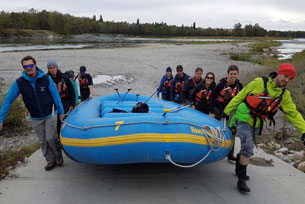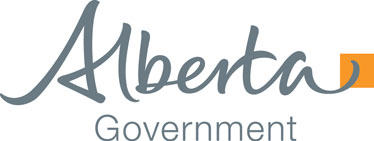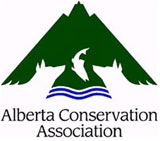Calgary river access
The Bow and Elbow rivers are integral to our city and provide extensive opportunities to promote social, economic, and environmental well-being in Calgary.
Drift boats, canoes, kayaks, or rafts powered by human efforts are welcome on the Bow River. The Federal Government prohibits any motorized watercraft such as motorboards or seadoos within Calgary city limits.
River access sites

Resources
River Safety
Know Before You Go
Do not go on or near the river during an advisory. You can check the river condition and any advisories by visiting Alberta Environment
- Even when an advisory is not in place, be cautious. Assess the river for any hazards and only enter if you feel your skill level can manage the current flow. To check for river flows visit the Alberta Rivers website. Understanding River Flow Rates.
- Check the weather - if there is a thunderstorm in the forecast reschedule for another day.
Bring the Right Gear
- Personal Floatation Devices (PFDs) or life jackets are not only a bylaw requirement, they can also save your life. They should be worn at all times when on or near the river. Make sure life jackets fit properly and are appropriate for your weight.
- Bring a spare pump, paddles/oars, an emergency kit, and water to stay hydrated.
- Rafts should be appropriate for river use. Whitewater rafts are made from strong sturdy materials such as polyester or nylon, and are typically coated with a synthetic rubber. Pool inflatables (air mattresses or inner tubes) are not recommended for use on the rivers, as they are not durable and can easily tear when they come into contact with rocks or debris.
- Motorized craft are prohibited on the Bow River in Calgary.
- Transport Canada requires that you bring a bailer, a whistle and 15m of buoyant heaving line, as well as one PFD/lifejacket and paddle per person.
Hazards on the Bow River
- 10 Street wave: Keep north (left) when approaching 10 Street. Not only is this wave dangerous for rafters, it also frequently has surfers who could be injured by oncoming rafts.
- At Harvie Passage there are two passages for river users:
- Eastern (river left) passage: This is considered a Class 3 passage. This passage should not be used by inexperienced or less-experienced boaters as the risk is significant. Experienced boaters should still exercise caution while navigating this passage.
- Western (river right) passage: This is a Class 2 passage. The waters are slower moving; however, caution is still required when navigating through this passage.
- There are also opportunities for less-experienced boaters to exit the river before the passage and portage the major water features.
- Always look out for other hazards to avoid such as trees, waves and rocks. Bridge pillars in particular can capsize even sturdy rafts.
- Never tie craft, such as rafts, together.
- Be aware that the Bow River may be very cold and very fast, and is generally not suitable for swimming.
Float Times
Float times are a conservative estimate and can vary greatly depending on the water level and flow of the rivers. The Bow River’s water level is normally higher in June and July, and so its flow is also faster at that time.
Elbow River:
- Sandy Beach to Stanley Park: 3 hours
- Sandy Beach to McDonald Bridge 6 hours
- Stanley Park to McDonald Bridge: 3 hours
Bow River North:
- West Baker Park to Shouldice Park: 2 hours
- West Baker Park to Edworthy Park: 3 hours
- West Baker Park to Sunnyside: 6 hours
- West Baker Park to St. Patrick's Island: 6.5 hours
- Shouldice Park to Edworthy Park: 1 hour
- Shouldice Park to Sunnyside: 4 hours
- Shouldice Park to St. Patrick's Island: 4.5 hours
- Edworthy Park to Sunnyside: 3 hours
- Edworthy Park to St. Patrick's Island: 3.5 hours
- Sunnyside to St. Patrick's Island: 0.5 hours
Bow River South:
- Ogden to Graves Bridge: 1 hour
- Ogden to Carburn Park: 2 hours
- Ogden to Douglasdale North: 3.5 hours
- Ogden to Fish Creek Park: 6 hours
- Ogden to Policeman's Flats: 9 hours
- Graves Bridge to Carburn Park: 1 hour
- Graves Bridge to Douglasdale North: 2.5 hours
- Graves Bridge to Fish Creek Park: 5 hours
- Graves Bridge to Policeman's Flats: 8 hours
- Carburn Park to Douglasdale North: 1.5 hours
- Carburn Park to Fish Creek Park: 4 hours
- Carburn Park to Policeman's Flats: 7 hours
- Douglasdale North to Fish Creek Park: 2.5 hours
- Douglasdale North to Policeman's Flats: 5.5 hours
- Fish Creek Park to Policeman's Flats: 3 hours
RIVER TRAVEL TIMES BOATS
Times vary with changing river flow rates
TIMES FOR CANOES, KAYAKS, AND PADDLEBOARDS
Bow River
- from West Baker to Inglewood: 2.5 to 3.5
- from West Baker to Graves Bridge: 4 to 5 hrs
- from Edworthy Park to Inglewood: 1.5 to 2.5 hrs
- from Harvie Passage to Graves Bridge: 1 to 2 hrs
- from Graves Bridge to Fish Creek-Sikome: 1.5 to 2.5 hrs
- from Fish Creek-Sikome to Policeman's Flats: 1 to 2 hrs
Elbow River
- from Sandy Beach to Inglewood: 2 to 3 hrs
TIMES FOR RAFTS
Bow River
- from West Baker to Shouldice Bridge: 1.5 to 2.5 hrs
- from West Baker to Sunnyside: 4 to 5 hrs
- from West Baker to Inglewood: 4.5 to 5.5 hrs
- from Shouldice Bridge to Sunnyside: 2 to 3 hrs
- from Shouldice Bridge to St. Patrick's Island: 3 to 4 hrs
- from Harvie Passage to Graves Bridge: 2 to 3 hrs
- from Graves Bridge to Fish Creek-Sikome: 3 to 4 hrs
Elbow River
- from Sandy Beach to Stanley Park: 1 hr
- from Sandy Beach to Inglewood: 3 to 4 hrs
TIMES FOR DRIFT BOATS
Bow River
- from West Baker to Shouldice Bridge: 3 to 5 hrs
- from Shouldice Bridge to St. Patrick's Island: 3 to 5 hrs
- from St. Patrick's Island to Graves Bridge: 3 to 5 hrs
- from Graves Bridge to Policeman's Flats: 3 to 5 hrs
Environment
Keep our rivers and riverbanks healthy and safe by ensuring the only thing that goes into our rivers or onto our banks is rain!
Specific river access sites have been selected because these sites pose the least risk to the environment. While river users may be used to other sites along the river, use of those sites may have serious consequences to our river environment. For example, walking along the riverbank, you may track harmful sediment into a particularly sensitive area. Or you may not be aware that where you launch your raft is an important fish spawning area. By using designated sites, you can help ensure the health of the river for years to come.
Litter and public urination are the most cited bylaw infractions. With portable toilets and garbage cans at each designated access point, river users can now do their part to make sure these harmful activities do not affect our environment.
The fish in our river are currently being affected by Whirling Disease which can be transmitted from infected locations to other bodies of water through infected equipment, fish or bait. Do your part to help stop the spread:
- Never move live or dead fish, or fish parts from one water body to another (this is illegal in Alberta).
- Use fish cleaning stations where available or put fish parts in the garbage. Never dispose of fish or any fish parts, in your kitchen garburator.
- It is illegal to use live fish as bait. The use of worms or leeches as bait should be avoided as well.
- Before moving a boat or any equipment (ie. hip waders, life jackets, kayaks, etc.) between water bodies, be sure to clean, drain and dry your watercraft or equipment.
For more information on whirling disease please visit Alberta Environment and Parks.
Fecal Coliform
River water quality can vary due to heavy rainfall and upstream sources such as agriculture, stormwater discharges, wildlife that live in the corridor, high river flows, recreation and other factors. Elevated levels of fecal coliforms are more readily observed in the Elbow River due to its small size and low flow. Water quality frequently does not meet recreational water quality guidelines.
Elevated levels of fecal coliforms typically found in the Elbow River can results in skin, ear and eye infection from any contact with Elbow River water. The public is advised to not drink this untreated river water as water-borne organisms, including fecal coliforms, can cause vomiting and diarrhea.
Alberta Health Services monitors the water quality of the Elbow River and frequently issues a warning advising the public not to swim or wade in the Elbow River, or drink the untreated river water. Due to these frequent advisories, The City of Calgary encourages users to consider using the Bow River instead of the Elbow River.
Please visit the Alberta Health Services website for information on current advisories.
River Access Strategy
In response to a notice of motion, The City of Calgary conducted extensive engagement and worked with internal and external partners to develop a Calgary River Access Strategy, which was approved by Council on February 13, 2017.
The Strategy focuses on four priority areas: criteria for identification of key river access points, environmental impact considerations, educational, and economic opportunities. The goal of the Strategy is to improve opportunities for recreation, environmental education, and economic endeavours on Calgary’s rivers, while ensuring public safety and the protection of riparian habitats.
Resources
General:
Environmental:
Kayaks and canoes:
- Alberta Whitewater Association
- Bow Waters Canoe Club
- Calgary Canoe Club
- Calgary Kayak Club
- Alberta Slalom Canoe Kayak
- Paddle Alberta
- Waterwerks Kayak Club
Fishing and drift boats:
Thank you to our funders and sponsors for helping us to implement designated river access sites:
The City's Partners:



